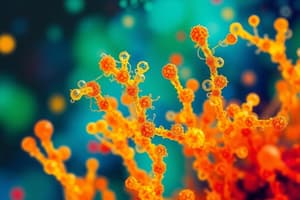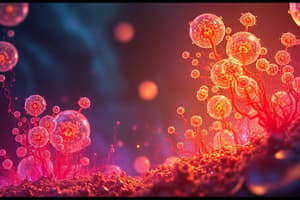Podcast
Questions and Answers
What classification of bacteria are specifically adapted to thrive in very low temperatures?
What classification of bacteria are specifically adapted to thrive in very low temperatures?
- Psychrophiles (correct)
- Mesophiles
- Thermoduric
- Thermophiles
Which type of microorganism would likely have the highest optimal growth temperature?
Which type of microorganism would likely have the highest optimal growth temperature?
- Mesophiles
- Hyperthermophiles (correct)
- Thermophiles
- Psychrophiles
Which temperature range is characteristic for mesophiles?
Which temperature range is characteristic for mesophiles?
- 20 to 45°C (correct)
- -10 to 0°C
- 0 to 20°C
- 45 to 100°C
What effect do low temperatures have on bacterial growth?
What effect do low temperatures have on bacterial growth?
What defines the maximum temperature for a microorganism?
What defines the maximum temperature for a microorganism?
Thermoduric bacteria are distinguished by which characteristic?
Thermoduric bacteria are distinguished by which characteristic?
Which statement accurately describes thermophiles?
Which statement accurately describes thermophiles?
Which of the following categories includes organisms that can grow at very high temperatures, above 80°C?
Which of the following categories includes organisms that can grow at very high temperatures, above 80°C?
The effect of temperature on prokaryotic growth can be characterized as:
The effect of temperature on prokaryotic growth can be characterized as:
What is the primary role of low temperatures in controlling bacterial populations?
What is the primary role of low temperatures in controlling bacterial populations?
What is the main reason for using low temperatures in food preservation?
What is the main reason for using low temperatures in food preservation?
Which heating method is specifically designed to achieve sterilization by using steam under pressure?
Which heating method is specifically designed to achieve sterilization by using steam under pressure?
What is the temperature setting of an autoclave that allows for effective sterilization?
What is the temperature setting of an autoclave that allows for effective sterilization?
Which bacterial species is likely to require the longest exposure time at boiling temperature to ensure effective microbial control?
Which bacterial species is likely to require the longest exposure time at boiling temperature to ensure effective microbial control?
What is the critical drawback of using boiling water as a method of sterilization?
What is the critical drawback of using boiling water as a method of sterilization?
Which pasteurization method is capable of achieving sterilization under proper conditions?
Which pasteurization method is capable of achieving sterilization under proper conditions?
What is the defining characteristic of dry heat sterilization compared to moist heat sterilization?
What is the defining characteristic of dry heat sterilization compared to moist heat sterilization?
What is measured by the thermal death time (TDT)?
What is measured by the thermal death time (TDT)?
At what temperature is the holding method of pasteurization typically conducted?
At what temperature is the holding method of pasteurization typically conducted?
Which temperature represents the optimal growth temperature for most mesophilic bacteria?
Which temperature represents the optimal growth temperature for most mesophilic bacteria?
What property allows bacterial endospores to survive in dry conditions?
What property allows bacterial endospores to survive in dry conditions?
What is the wavelength range of UV radiation?
What is the wavelength range of UV radiation?
What type of DNA damage is primarily caused by UV radiation?
What type of DNA damage is primarily caused by UV radiation?
How can UV radiation lead to cell death after prolonged exposure?
How can UV radiation lead to cell death after prolonged exposure?
In what environments is UV radiation typically used to control microbial growth?
In what environments is UV radiation typically used to control microbial growth?
Which component of DNA is affected by the formation of pyrimidine dimers?
Which component of DNA is affected by the formation of pyrimidine dimers?
What precaution should humans take when using UV radiation for sterilization?
What precaution should humans take when using UV radiation for sterilization?
What happens to DNA when it forms pyrimidine dimers?
What happens to DNA when it forms pyrimidine dimers?
Which method is NOT mentioned as a function of UV radiation?
Which method is NOT mentioned as a function of UV radiation?
What type of microorganisms can persist in the environment aside from endospore formers?
What type of microorganisms can persist in the environment aside from endospore formers?
Flashcards are hidden until you start studying
Study Notes
Temperature and Microbial Growth
- Temperature affects bacterial growth - different bacterial species have different temperature requirements for growth.
- Microbial growth is strongly influenced by temperature and can be used to control bacterial growth.
- Temperature ranges for different bacterial species:
- Psychrophiles: -10°C to 20°C.
- Mesophiles: 20°C to 45°C.
- Thermophiles: 45°C to 80°C.
- Hyperthermophiles: 80°C to 110°C.
- Thermoduric bacteria - can survive short bursts of heat but will only grow at lower temperatures.
- Temperature control methods:
- Low temperatures: Primarily bacteriostatic - inhibit bacterial growth and/or reduce the total number of bacteria.
- High temperatures: Bactericidal - can kill bacteria.
- Sterilization: using high temperatures to kill all forms of life.
- Methods of sterilization:
- Incineration: high-temperature flames for materials that can withstand it.
- Dry heat: uses oxidation of cellular molecules and desiccation (drying) of bacteria.
- Moist heat: denatures nucleic acids and enzymes, rendering bacteria incapable of metabolizing or reproducing.
- Moist heat methods:
- Boiling: 100°C at sea level, kills many vegetative cells, but not all bacteria.
- Pasteurization: Heat treatment used for food items
- Holding method (63°C for 30 min)
- Flash pasteurization (71.6°C for 15 sec)
- Ultra-high temperature (UHT) (140°C for 3 sec)
- Autoclave: uses steam under pressure (121.5°C), capable of sterilizing materials.
- Methods of sterilization:
- Factors affecting sterilization efficiency:
- Thermal death time (TDT): minimum time required to kill a population of microbes at a specific temperature.
- Thermal death point (TDP): lowest temperature required to kill a population of microbes in a specific amount of time.
Other Factors Affecting Microbial Growth
- Moisture: All living organisms, including bacteria, require water to survive.
- UV radiation: Damages DNA by forming pyrimidine dimers, which disrupt DNA replication and transcription.
- UV radiation can be used for controlling microbial growth in specific areas.
- However, UV radiation can damage skin cells.
- Endospores: Resistant to dryness, can survive for extended periods in dry environments and germinate to form vegetative cells when moisture is available.
- Cell wall properties and glycocalyx: Affect the ability of certain non-spore-forming bacteria to persist in dry environments.
Studying That Suits You
Use AI to generate personalized quizzes and flashcards to suit your learning preferences.




